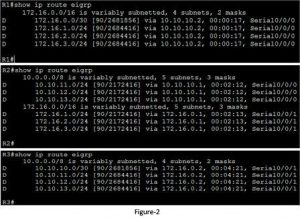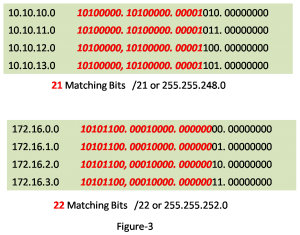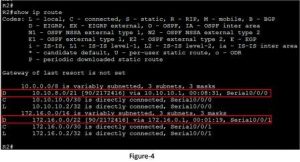We can configure manual summary routes without enabling the auto-summary. We can also use a manual summary if auto-summary is enabled because EIGRP is a classless routing protocol. Classless routing protocol includes the subnet mask in the routing update; therefore we can configure manual summarization using the supernet routes. In supernetting, we can aggregate multiple routes in one major classful network address.
Configuring EIGRP Manual Summary Routes
Figure 1 illustrates the topology for manual summary route configuration. This is the same topology we have already used in EIGRP auto-summary configuration. R1 has four adjacent routes and R3 has also the four adjacent routes. We can manually summarize the routes.

We can examine the routing table of R1, R2, and R3 to verify the EIGRP routes in the routing table for network 10.10.10.0/30, 10.10.11.0/24, 10.10.12.0/24, 10.10.12.0/24, 172.16.0.0/30, 172.16.1.0/24, 172.16.2.0/24, and 172.16.3.0/24. Figure 2 illustrates the routing table of all three routers in the above topology, before the manual auto-summarization.

Steps for Determining Summary Route
To determine the summary route follow the steps below separately for networks that need to summarize.
- Write all the network’s binary format that needs to summarize.
- Start from for left to summarize all the networks.
- Find all the consecutive matching bits from left to right
- Mark all the matching bits in all networks in the column of bits to define the summary boundary.
- Count the number of matching bits, which in this example you can see in figure 3 shown in red and italic.
- To find the network address for summarization, copy the matching bits and add all 0 bits to the remaining positions to complete 32 bits address.

The resultant summary network address and mask for the network of router R1 are 10.10.8.0/21 and for the network of the router, R2 is 172.16.0.0/22.
Configure EIGRP Manual Summarization
Now we have found the summary routes for the networks of both routers. To configure EIGRP manual summarization on a specific EIGRP interface, the interface mode command syntax is “Router(config-if)# ip summary-address eigrp <as-number> <network-address> <subnet-mask> “. So let’s configure the EIGRP summary route on both R1 and R2.
| Router R1
R1(config)#interface serial 0/0/0 R1(config-if) ip summary-address eigrp 10.10.8.0 255.255.248.0 R1(config-if)# Router R2 R2(config)#interface serial 0/0/1 R2(config-if) ip summary-address eigrp 192.168.0.0 255.255.252.0 R2(config-if)# |
The configuration on R1 will propagate the route 10.10.8.0/21 network on serial 0/0/0 interface. In the router R2, the configuration will propagate the summary route on serial 0/0/1 interface of R2.
Verifying Manual Summary Routes
We can verify the summary router configuration by showing the routing table for R2 because both summary routes are propagated towards R2. Figure 4 illustrates the routing table of R2 after the summary route is configured. The routing tables of R2 has no longer include the individual route or R1 and R3. Instead, the routing table of R2 displays a single summary route of 172.16.0.0/22 and 10.10.8.0/21.

More router decrease the routing table lookup process efficiency, but summary routes decrease the number of routes in routing tables which increases the efficiency. Summary routes also utilize less bandwidth for the routing updates, so a single route can be sent instead of multiple individual routes.




